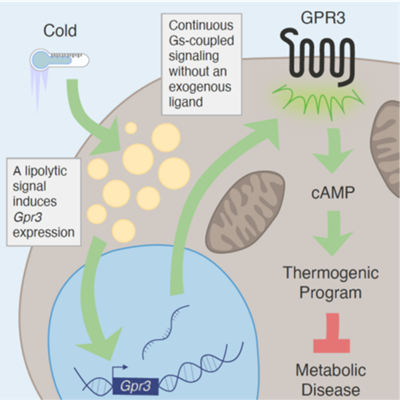When we think of cell surface receptors, we most likely consider ligand-binding as the critical point of control: A ligand binds to its receptor, triggering a conformational change which ultimately causes the receptor to convey downstream signaling. In this study, on the other hand, Sveidahl Johansen et al. asked the question to which extent receptor signaling is impacted by acute transcriptional regulation of the G protein-coupled receptors (GPCRs) themselves. They surveyed the transcription of GPCRs in cold-challenged mice and found that Gpr3 was the most cold-induced Gs-coupled receptor in thermogenic adipose depots. GPR3 belongs to a family of constitutively active receptors, and the authors showed that the N terminus of the receptor confers this innate ability of GPR3 to potently signal through Gs-coupling – and boost cAMP levels within the cells – without the need of an external ligand. Because GPR3 begins signaling upon reaching the cell surface, the transcriptional induction of the receptor becomes an analogous activating event to ligand-binding of more conventional receptors. Hence, stimulating Gpr3 transcription alone is sufficient to drive cAMP-dependent thermogenesis in adipocytes.
Strong collaborative efforts within ADIPOSIGN established that a lipolytic signal is responsible for the profound cold-dependent transcriptional induction of Gpr3. However, the signaling cascades and transcription factors involved in this lipolytic control of Gpr3 remain unknown. The lipolysis angle on the project was aided by compounds developed in the Granneman lab, which demonstrates one of the many connections between ADIPOSIGN and ATLAS, where Prof. Granneman is member of the Scientific Advisory Board. In her PhD project, funded by ADIPOSIGN, Olivia Sveidahl Johansen is actively investigating the machinery orchestrating the transcriptional regulation of Gpr3.
The work on GPR3 is published in Cell, and you can read more about how the ADIPOSIGN scientists turn up calorie burning in brown fat with a unique on-switch, and watch a video with PhD fellow Olivia Sveidahl Johansen and Professor Zach Gerhart-Hines explaining their findings here.
